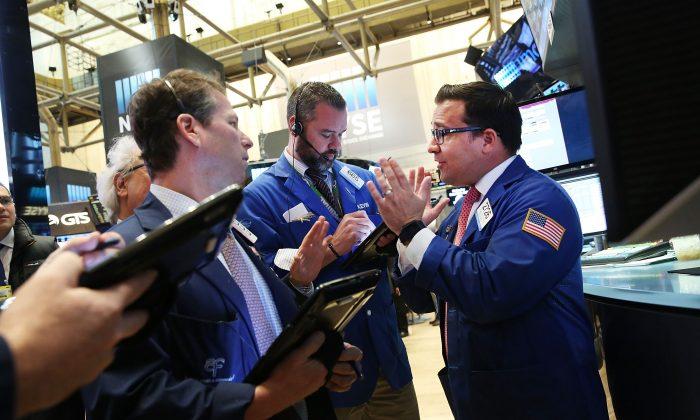U.S. stocks have been resilient in 2016, but as an uncertain June begins, debate abounds on where we go from here.
Sentiment is negative even as the S&P 500 on June 1 sits within 1.5 percent of its all-time closing high hit last summer. Event risk is high: A potentially imminent Fed rate hike and new projection of future hikes approach; the uncertainty of the “Brexit” vote follows shortly. Both could dramatically affect stocks.
BlackRock downgraded global stocks to neutral in a May 31 note. Regarding U.S. stocks, BlackRock’s global chief global investment strategist Richard Turnill said in the note, “The growing likelihood of an imminent Fed rate increase and more elevated U.S. valuations warrant short-term caution.”
The harbinger of change is short-term real bond yields (nominal yields adjusted for inflation), which stopped falling and started rising in April. The Federal Reserve’s Beige Book discussed inflation moving higher, which gives it more ammunition to raise rates.
Turnill says stocks have been in a “sweet spot” since mid-February. As of Feb. 11, the S&P 500 was down 10.5 percent for 2016. But as of June 1, it’s up 2.7 percent.
“Very few people buy into the idea that stocks are a good deal right now,” RBC Wealth Management’s Alan Robinson tells Epoch Times. But even though he feels the factors that boosted stocks from their February lows wane, there’s so much cash on the sideline now that there’s more “risk of a ’melt-up' than a meltdown” for stocks.
“When you have sentiment this low, it’s generally a good indicator for the long-term return in stocks,” Robinson says.
Valuation Conundrum
The stock market bears say stocks are expensive on a historical basis, but the bulls counter by pointing out that stocks are cheap relative to bonds.
“U.S. equity valuations sit around the 70th percentile of their long-term historical range,” said Turnill. FactSet noted on May 27 that the S&P 500 forward 12-month price-to-earnings (P/E) multiple of 16.7 is above both the 5- and 10-year averages.
Robinson sees 2,225 as a year-end level for the S&P 500—about 6 percent higher. He arrives at his target using a 17.5 P/E multiple and aggregate S&P earnings of $127. The 17.5 includes a bit of “multiple expansion,” which he thinks the S&P will get by year-end.
The 17.5 multiple isn’t particularly expensive considering it was in the mid-20s around 2000 (and even higher for tech companies), says Robinson. The corresponding earnings yield of 5.7 percent when compared to the 10-year bond yield of 1.85 percent is a good deal, he says.
“You can argue for a slow move higher in valuation multiples and perhaps a fast move higher if all this cash, which is sitting on the sidelines, comes back in to the market,” Robinson says.
In contrast, Marc Faber, publisher of the Gloom, Boom & Doom report, is downright bearish.
“Stocks are still very vulnerable,” Faber said in a June 1 interview with CNBC. He thinks earnings will still be under pressure and that the bond market is implying ongoing economic woes. He advocates buying gold, mining stocks, and precious metals like platinum and silver.
To Faber’s point about earnings, FactSet reported the blended earnings decline for Q1 is -6.7 percent (with 98 percent of companies reporting as of May 27). The majority of companies reporting declining Q1 earnings are issuing negative guidance for Q2.
Robinson thinks Q1 was a bottom for earnings and that the aggregate earnings decline can be explained by stripping out the largest banks and the energy sector.
“We still frankly think we’re in the ‘Goldilocks’ zone,” Robinson says, since economic data is mixed, meaning interest rates will stay low and economic growth is positive enough that the threat of a recession is remote.
“We also see the potential for a corporate earnings recovery later in 2016,” said Turnill.
Faber said equities only make up 25 percent of his portfolio, the second-largest component of which is gold and Treasury bonds.
To Faber, the 10-year U.S. Treasury bond may have a lower yield than the dividend yield of the S&P 500 (2.05 percent), but it’s a good deal relative to comparable government bonds from Germany (0.13 percent yield) and Japan (-0.12 percent yield).
Pecking Order
The risk Britain leaves the European Union—Brexit—is another uncertainty hanging over U.S. stocks. Should the “leave” votes win, stocks will suffer globally, says Robinson.
But a pecking order should take hold with U.S. stocks outperforming European stocks, which in turn would outperform U.K. stocks. Robinson calls U.S. stocks “the least bad house in the neighbourhood” under a Brexit scenario.
Stock markets don’t like uncertainty, but with the S&P 500’s “fear index,” the VIX, at a tame level around 14, perhaps some complacency has set in. Events in June could cause the VIX to spike and the stock market to sell off. But eventually, earnings are expected to strengthen, which should give U.S. stocks another leg to stand on.
Follow Rahul on Twitter @RV_ETBiz





